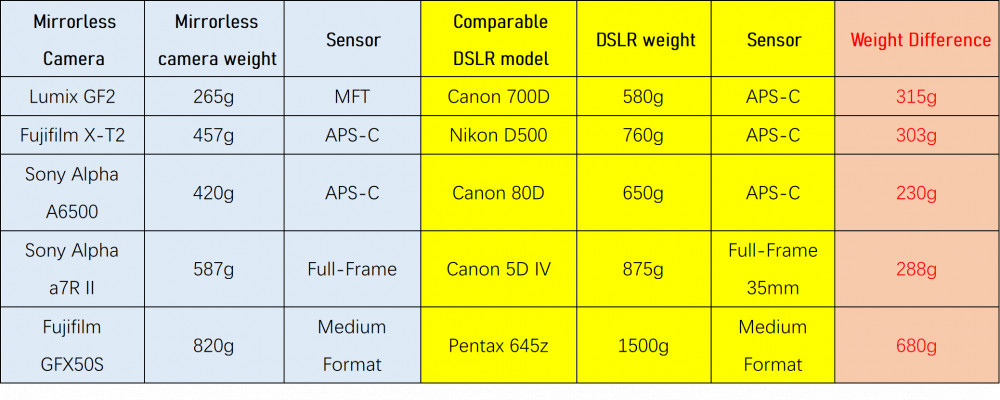At this juncture of digital cameras evolution, it can now be safely said that the time has finally come why mirrorless cameras are better than it was 10 years ago.
Competition-wise, it has managed to even the gap with its cousins- the DSLRs. There’s no more debating on whether mirrorless cameras could even compete.
Now what you will be hearing that is being discussed in forums is either mirrorless cameras can supplant DSLRs to extinction.
Arguably, the latter may not happen very soon.
However, as technology advances and innovative solutions to produce more high-end compact mirrorless cameras are being developed, it is likely possible that in the foreseeable future DSLR may lose the battle with mirrorless cameras.
Professionals and camera enthusiasts alike now know that what the DSLR can do, the Mirrorless Cameras can also do and to some extent even better.
Taking all that into account, the future of mirrorless cameras is just going to get bigger and brighter the same way how it has proven itself in the past decade.
Surveys and statistics are available online and according to the latest numbers, digital camera manufacturers have produced and shipped out more mirrorless cameras than DSLRs in 2021.
If things continue to happen the way they have been happening at this rate, DSLRs could be gone (only maybe) unexpectedly sooner than later!
The justification that professionals don’t use mirrorless cameras is now a myth!
Below 5 Reasons Why Mirrorless Cameras Are Better
1. Compact Design
This attribute will always remain a good selling point for mirrorless cameras. And this is especially true for Micro Four Thirds as it is sporting a much smaller sensor while for APS-C system’s sensor is slightly bigger.
APS-C systems are both used in DSLR and Mirrorless Cameras. And in this format alone you’ll find a significant difference in size and weight when compared, that all favor mirrorless cameras.
Some would say, well it’s only several hundred grams and a few centimeters will not make any difference for me!
But in reality, any reduction in weight and size would benefit you because it can save you more load and space. Since mirrorless cameras are lighter and smaller it is easier to bring along especially when traveling.
Even the slightly bigger Full-Frame system mirrorless camera when compared side by side with DSLR still has a smaller body size and is also lighter!
And speaking of Full-Frame system mirrorless cameras, recently Canon has introduced its latest model targeting professionals and enthusiasts.
While still aiming to further bolster its lineup with the goal of expanding more imaging possibilities for its users. What does this mean? This means that competition with the DSLRs has just been intensified.
If other big names in the camera industry will follow Canon’s lead (which they are expected), then we could anticipate a further drop in DSLR’s share of the market that has already been hit by the emergence of Micro Four Thirds and APS-C systems mirrorless cameras.
2. Portability
Some may argue about the size and weight difference are just minimal and therefore negligible as the basis for portability.
In the case of Full-Frame mirrorless cameras, maybe yes.
However, in the case of Micro Four Thirds and APS-C systems the contrasting size and weight difference is proof that a smaller and lighter object will always be easier to carry than a bigger and heavier object.
And as I already mentioned earlier, any savings in size and weight will benefit you since you now can load other things with the extra space you get.
The below table shows a sample of the body weight difference between a mirrorless camera and a DSLR.

3. Superior Auto Focus For Video Capture
Autofocus is one key feature that mirrorless camera enjoys over DSLRs. Mirrorless cameras employ phase-detection AF sensors that are far more effective than contrast-detection in DSLRs.
While recording video with DSLR, the mirror has to be flipped up and it’s blocking the primary autofocus thus relying on contrast detection that results in some blurry look when the camera starts searching for the right focus.
In addition, Canon recently released its new model EOS R3 full-frame mirrorless camera unveiling its latest and innovative technology the Eye Control AF.
This means that AF tracking will come in very handy because it can track and focus your subject by just following your eye movement.
4. EVF for Mirrorless Camera vs OVF for DSLR
EVF (Electronic View Finder) on mirrorless cameras does not have a viewfinder blackout during burst shooting or continuous shooting.
While the opposite can be said for DSLR’s OVF (Optical View Finder) because you can always experience a viewfinder blackout when shooting continuously or shooting in burst mode.
5. Human, Animal, Machine Recognition Capabilities
Aside from people (face, head recognition), the latest models of mirrorless cameras have now the ability to recognize and track animals such as dogs, cats, and birds as well as automobiles like racing cars and motorcycles.
This is particularly evident with Canon’s latest model released this November 2021 where they have developed and integrated Deep Learning Technology into their model EOS R3 that helps improve subject recognition and AF tracking.
With this new development in Canon’s quest for more sophisticated mirrorless cameras, it will not take long before other major brands dive in and develop their own to counter Canon.
And it would only mean more innovations and advancements for mirrorless cameras and will further push DSLRs to the side.
Final Thoughts
A little disclaimer, I have owned two mirrorless cameras and have been a mirrorless camera supporter!
It may not come very soon but the trend is shaping in favor of Mirrorless Cameras. There are still other aspects that also put mirrorless cameras in front of DSLRs which I have not touched on in this article.
Ten years ago no one would’ve believed that mirrorless camera is the future of digital cameras.
Many experts have downplayed that this new system could take over what has been dominated for many years by DSLRs.
In the past decade or so, we have witnessed the evolution of a new system that will lead and reshape the future of digital cameras.
Regardless of the weakness thrown on mirrorless cameras’ battery life. It will not stop people from buying because of fact that it can be solved by bringing an extra battery. Which you would also do with your DSLR.
Personally, I have an extra battery in my camera bag every time I go out to shoot (just in case).
But in reality, you can accomplish a lot even by just using one battery pack.
Do you really need to shoot 1000 or 3000 shots with one battery?
No!
… or maybe some shooters really do.
But my point is that you would also bring a spare battery even if you are using a DSLR.
That’s why the argument on poor battery life will not deter new buyers to consider and get a mirrorless camera instead.
That’s just about it, my two cents worth.
If you have any comments or suggestions, please leave them below and I will answer them to the best of my knowledge. Thank you for reading!

About Rowe Medialdea:
Hi, I’m Rowe, a mirrorless camera and photography enthusiast. We have created this site to be of help (especially to beginners) by producing easy-to-understand content about mirrorless cameras! Welcome to our website!

